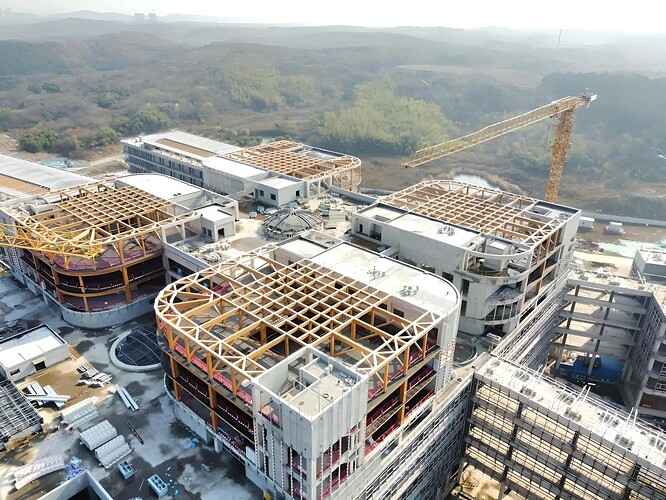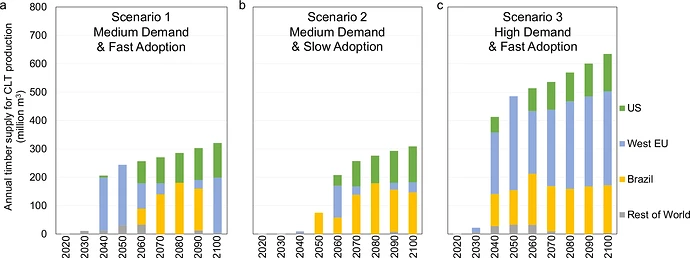In Jiangsu Province, China, a new project has made headlines for being the nation’s first to utilise a “wood-concrete composite structure” for large-scale buildings. The Jiangsu Provincial Rehabilitation Hospital leverages a unique construction technique that combines mass timber and concrete to balance strength, sustainability, and seismic resilience. Now, researchers argue that not only can mass timber help remove embodied carbon in the building industry, but can provide an incentive for forest managers to manage resources over multiple decades. (Photo Credit: China Academy of Building Research)
Scaling up cross-laminated timber quickly can not only tackle embodied carbon in buildings – by replacing high-carbon steel and concrete with low and (near) zero-carbon products – but, crucially, improve carbon absorption in better-managed and productive forests – multiplying greenhouse gas (GHG) benefits over decades.
That is according to a new study, Global land and carbon consequences of mass timber products, which revealed for the first time that higher wood prices generated from mass timber products, like glulam, cross-laminated timber, and laminated veneer lumber, will expand productive forestlands and most importantly lead to far better outcomes in the forest.
Click here to download the research
“Our results show that higher wood prices reduce the production of traditional wood products but expand productive forestland by 30.7–36.5 million hectares from 2020 to 2100 and lead to more intensive forest management,” according to the study led by Kai Lan from the Yale School of the Environment. “If the cumulative global cross-laminated timber production reaches 3.6 to 9.6 billion cubic metres by 2100, long-term carbon storage can increase by 20.3–25.2 GtCO2e, primarily in forests (16.1–17.7 GtCO2e) and in cross-laminated timber panels (4.1–8.1 GtCO2e).”
“Including emission reductions from steel, cement, and traditional wood products, the net reduction of life-cycle greenhouse gas emissions will be 25.6–39.0 GtCO2e.”
Wood Central understands that the study is the first time that researchers have looked at the whole mass timber supply chain – and not just at the product level – analysing how rising demand impacts forest use, carbon cycles and emissions – and uses ecological modelling, economic forecasting and life cycle assessment to look at three different scenarios:
[
](data:image/svg+xml;base64,PHN2ZyB4bWxucz0naHR0cDovL3d3dy53My5vcmcvMjAwMC9zdmcnIHZpZXdCb3g9JzAgMCAxNzI4IDY0OCc+PC9zdmc+)Scenario 1 has medium demand and fast adoption; Scenario 2 has medium and slow adoption; and Scenario 3 has high demand and fast adoption. The global sawtimber supply for cross-laminated timber in the three scenarios is shown for various major regions, including the US (United States of America), West EU(Western Europe, and Brazil, along with the rest of the world. (Photo Credit: Supplied)
“(This) framework will improve understanding of how the timber market and specifically forest landowners will respond to the higher wood prices from the new demand for cross-laminated timber,” the researchers said. “The framework reveals that the adoption rate affects this response since it takes time to grow an additional wood supply. More importantly, it shows that landowners will act in anticipation of a new demand that has not been recognised in previous studies.”
The study found that while the direct emissions from increased cross-laminated timber production (as captured by the life cycle analysis) would rise slightly, by 1.6 to 2.4 GtCO2e by 2100, this increase is more than offset by reductions in avoided cement, steel use and wood waste. “When all factors are considered, total emissions could fall by 1.9 to 9.7 GtCO2e, translating to a net reduction of 7.1 % to 24.7 % in cumulative emissions by century’s end,” they said.
“The most substantial carbon gains were linked to the forest. Higher wood prices driven by cross-laminated timber demand (acts) incentivise landowners to plant new forests and intensify management of existing ones.”
The researchers said the plantation forest area is projected to increase by 11 to 14.7 million hectares by 2100, while managed forestland could grow by 27.9 to 40.8 million hectares. And although some natural forestland is expected to decline (by between 8.1 and 18.9 million hectares), the overall effect is a net increase in forest area and stored carbon.
[
](data:image/svg+xml;base64,PHN2ZyB4bWxucz0naHR0cDovL3d3dy53My5vcmcvMjAwMC9zdmcnIHZpZXdCb3g9JzAgMCAxOTgzIDU3OSc+PC9zdmc+)Scenario 1 with medium demand and fast adoption; Scenario 2 with medium demand and slow adoption; Scenario 3 with high demand and fast adoption. Positive values imply increased greenhouse gas (GHG) emissions, and negative values imply reductions in GHG emissions or increases in CO2 sequestration relative to the baseline. CLT stands for cross-laminated timber; EOL stands for end-of-life.
Mass timber incentives can drive improved outcomes in the forest.
According to the researchers, policies that support this transition, such as subsidies or building code incentives, could accelerate the climate benefits: “The results suggest that it would be reasonable to subsidise the demand for cross-laminated timber as a GHG mitigation strategy.”
“By increasing the market value of timber, the subsidy would provide an additional market incentive to maintain the world’s existing forests. Given the difficulties of regulating global land use, this subsidy would be a practical tool to increase carbon storage in forests,” they said.
Journal Reference: Lan, K., Favero, A., Yao, Y., Mendelsohn, R. O., & Wang, H. S.-H. (2025). Global land and carbon consequences of mass timber products. Nature Communications, 16(1). DOI: 10.1038/s41467-025-60245-y, https://www.nature.com/articles/s41467-025-60245-


